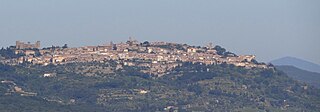
Montalcino is a hill town and comune in the province of Siena, Tuscany, central Italy.

Volterra is a walled mountaintop town in the Tuscany region of Italy. Its history dates from before the 8th century BC and it has substantial structures from the Etruscan, Roman, and Medieval periods.
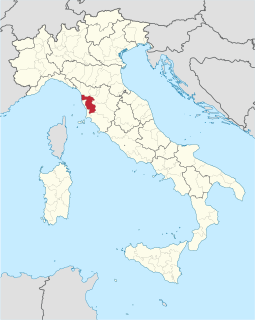
The province of Pisa is a province in the Tuscany region of central Italy. Its capital is the city of Pisa. With an area of 2,448 square kilometres (945 sq mi) and a total population of 421,642, it is the second most populous and fifth largest province of Tuscany. It is subdivided into 37 comuni.

Populonia or Populonia Alta today is a frazione of the comune of Piombino. As of 2009 its population was 17. Populonia is especially noteworthy for its Etruscan remains, including one of the main necropolis in Italy, discovered by Isidoro Falchi.

San Miniato is a town and comune in the province of Pisa, in the region of Tuscany, Italy.

Bibbona is a comune (municipality) in the Province of Livorno in the Italian region Tuscany, located about 80 kilometres (50 mi) southwest of Florence and about 40 kilometres (25 mi) southeast of Livorno in the Val di Cecina.

Campiglia Marittima is a comune (municipality) in the Province of Livorno in the Italian region Tuscany, located about 90 kilometres (56 mi) southwest of Florence and about 60 kilometres (37 mi) southeast of Livorno.

Lajatico is a comune (municipality) in the Province of Pisa in the Italian region Tuscany, located about 50 kilometers (31 mi) southwest of Florence and about 40 kilometers (25 mi) southeast of Pisa. Lajatico sits in mainly hilly terrain at variable elevations from 100 to 650 meters above sea level) and dominates both the end of the Valdera valley and the opening of the valley known as Val di Cecina.
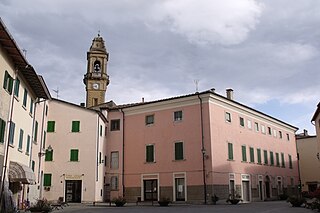
Pomarance is a comune (municipality) in the Province of Pisa in the Italian region Tuscany, located about 60 kilometres (37 mi) southwest of Florence and about 60 km southeast of Pisa.

Tuscany is a region in central Italy with an area of about 23,000 square kilometres and a population of about 3.8 million inhabitants. The regional capital is Florence (Firenze).
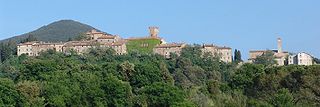
Querceto is a frazione in the comune of Montecatini Val di Cecina of the Province of Pisa in Italy. The village is located on the slopes of Mount Aneo, near Volterra
The Pomarancina is a breed of domestic sheep from Tuscany in central Italy. It is raised mainly in the comune of Pomarance, from which it takes its name, and in the neighbouring comuni of Castelnuovo di Val di Cecina, Montecatini Val di Cecina and Volterra, all in the province of Pisa; some are kept in other parts of Tuscany, in the provinces of Grosseto, Livorno, Lucca and Siena. It is one of the forty-two autochthonous local sheep breeds of limited distribution for which a herdbook is kept by the Associazione Nazionale della Pastorizia, the Italian national association of sheep-breeders.
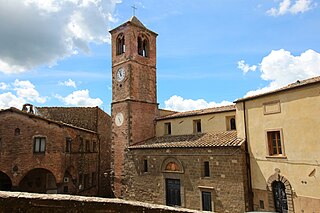
San Biagio is a romanesque-gothic style Roman Catholic church. It was erected during the 14th century in the town of Montecatini Val di Cecina, province of Pisa, in the region of Tuscany, Italy.

Casaglia is a village in Tuscany, central Italy, administratively a frazione of the comune of Montecatini Val di Cecina, province of Pisa. At the time of the 2001 census its population was 10.

Miemo is a village in Tuscany, central Italy, administratively a frazione of the comune of Montecatini Val di Cecina, province of Pisa. At the time of the 2001 census its population was 13.
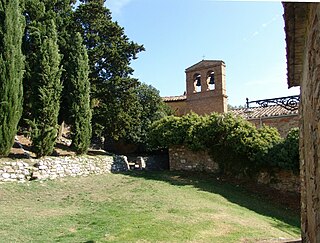
Gello is a village in Tuscany, central Italy, administratively a frazione of the comune of Montecatini Val di Cecina, province of Pisa. At the time of the 2006 parish census its population was 88.

Ponteginori is a village in Tuscany, central Italy, administratively a frazione of the comune of Montecatini Val di Cecina, province of Pisa. At the time of the 2001 census its population was 532.
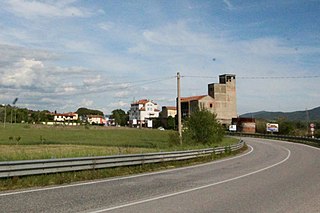
Casino di Terra is a village in Tuscany, central Italy, administratively a frazione of the comuni of Guardistallo and Montecatini Val di Cecina, province of Pisa. At the time of the 2001 census its population was 97.

La Sassa, or simply Sassa, is a village in Tuscany, central Italy, administratively a frazione of the comune of Montecatini Val di Cecina, province of Pisa. At the time of the 2001 census its population was 152.
Buriano is a village in Tuscany, central Italy, administratively a frazione of the comune of Montecatini Val di Cecina, province of Pisa.






















